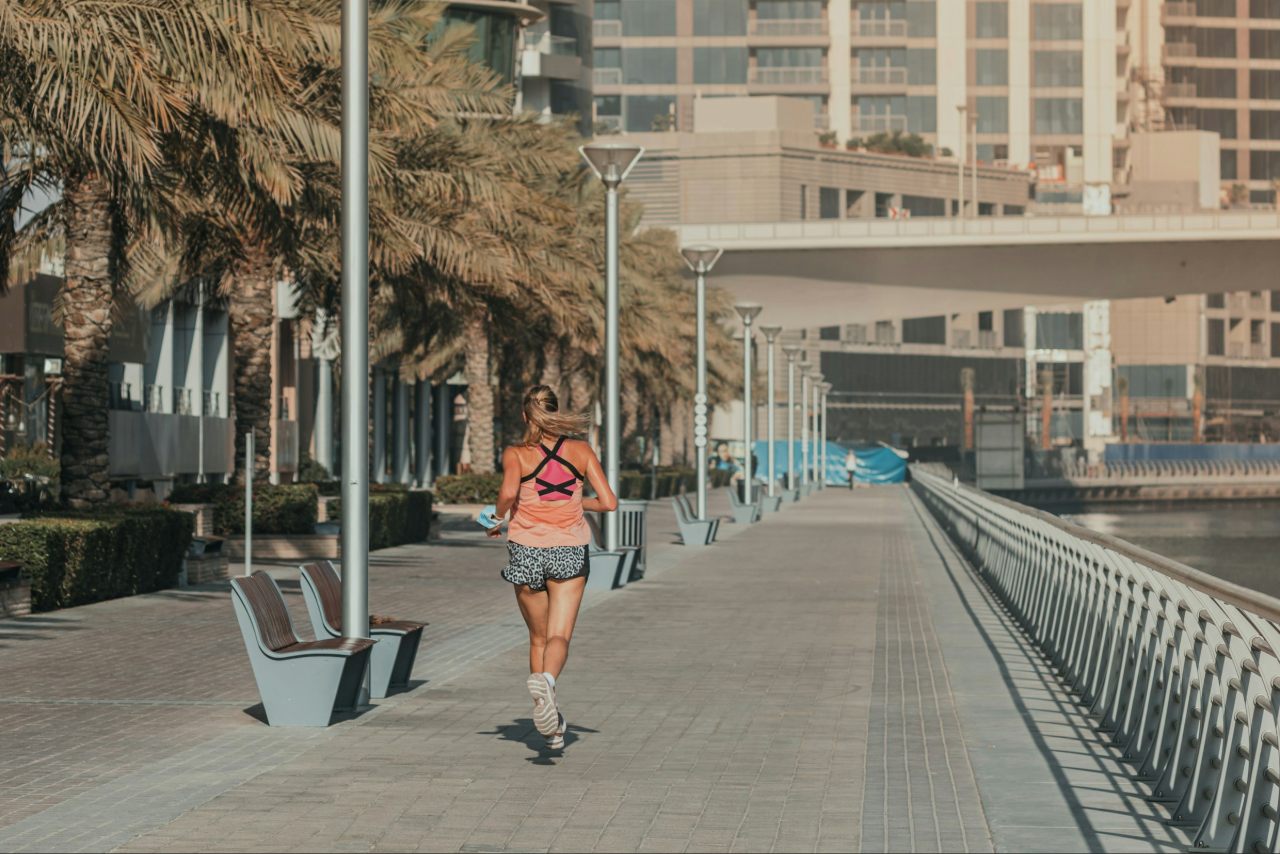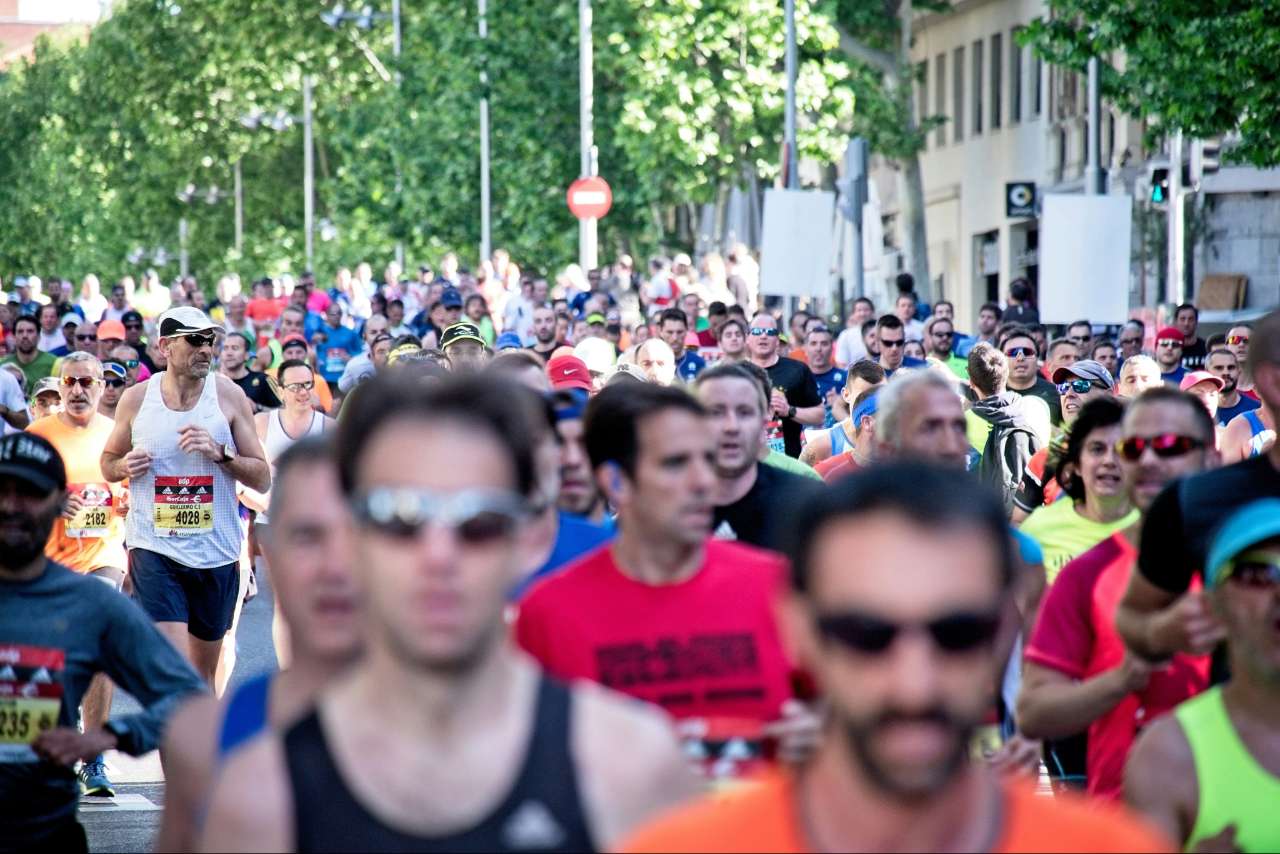Running in the rain can be an exhilarating experience, making you feel invincible and turning a regular run into an adventure.
However, we have found the only way to finish a soggy run in a good mood, feeling accomplished rather than defeated, is planning. Wearing the correct clothing, planning your route and ensuring you have the right shoes on will all help to ensure you give yourself the best chance to end your run with a smile on your face.
Whether you intentionally embrace the rain or find yourself unexpectedly caught in a downpour, preparation is the key to turning challenges into opportunities. Below, you’ll find some of our top tips on how to give yourself the best chance of success in the rain:
- Tips 1 to 6 are about what to wear when running in the rain
- Tip 7 is about planning your route
- Tip 8 is about pacing
- Tips 9 to 12 are post-run tips
- Tips 13 and 14 are about mindset
Tip 1: Get a running waterproof jacket
When running in the rain, a waterproof jacket is a must-have. Find one that breathes, keeping you dry without making you feel like you’re in a sauna.
Getting one with a compact design allows easy storage in hydration vests or pockets, making it a practical and versatile solution for your rainy day runs. These are also great in temperamental weather when you need adaptability to match constantly changing weather conditions.
Our recommendation: HOKA Skyflow Jacket
Tip 2: Consider investing in waterproof running shoes
Soggy feet can make running miserable, often meaning you don’t get the most out of your session. If you regularly get caught in wet conditions, it may be worth investing in waterproof running shoes. These can help to keep your feet dry and comfortable.
As each person is different it may be worth heading down to your local running shop to try some options on and ensure they are right for your feet.
Have a look at our blog on waterproof running shoes for more in-depth advice from our coaches.
Running in wet conditions often leads to mud building up on the bottom of your shoe causing loss of treading and impacting grip, whilst also adding weight to each stride. Make sure to regularly check the sole and scrape any mud for better traction and to avoid slipping.
Tip 3: Wear quick-dry clothing
Wearing items that use materials like cotton will just absorb water, becoming heavy and causing chaffing. Quick-dry, moisture-wicking clothing will ensure you have a more comfortable run, because it’s lightwright and helps regulate body temperature.

Also consider using socks made of technical fabrics, too, so that the inevitable wet feet aren’t made worse with added weight and chafing.
Tip 4: Use a running cap
Shield your eyes from the rain with a breathable running cap or visor. This will help improve visibility, enabling you to stay focused on the path ahead without rain getting in your eyes, making you squint. Also, as a large percentage of your body heat escapes from your head, we recommend getting a cap that uses breathable materials on warmer days to avoid overheating. Make sure that it fits comfortably, not being too tight or loose.
Tip 5: Use Body Glide for chafe prevention
In wet conditions, chafing is more likely. We suggest applying body glide or a similar anti-chafing product to areas prone to friction before heading out. We all know how uncomfortable chafing can be, but thankfully there are easy solutions!
Tip 6: Stay visible
Grey weather and pelting rain often means reduced visibility, especially for drivers. Wearing reflective gear or brightly coloured clothing will ensure you remain visible to drivers and other pedestrians, giving them the best chance of seeing you in difficult conditions and keeping you safe.
Tip 7: Pick your route carefully
A bit of pre-planning and consideration of the impact the rain may have on your usual routes may help prevent unexpected route changes.
Opt for a well-drained route to avoid waterlogged areas or excessively muddy trails and, if possible, steer clear of main roads with cars that may splash you. Trails you know that have effective drainage and paved paths can make your rainy runs more enjoyable. It may also be worth picking a route you know you can cut short in case the weather takes a turn for the worst.
Tip 8: Adjust your pacing
Slippery surfaces and sticky mud may affect your grip and ability to run quickly. On rainy days, it may be better to swap out one of your faster-paced threshold or tempo runs with an easy, steady-paced run so you can maintain a stable and controlled stride and reduce the risk of slipping. Also, be aware it may be unrealistic to aim for a PB in these kinds of conditions.
Tip 9: Don’t forget to cool down
At the end of your run, it is understandable you may want to get out of the rain as quickly as possible to get dry and warm. As tempting as it may be to jump straight in the shower post-run, don’t forget to cool down effectively to prevent injuries and promote recovery.
On really rainy and cold days, finding cover or removing muddy shoes and having a quick stretch inside may be more enjoyable than staying outside. Read more here on the importance of a post-run cool down and have a look at best cool down stretches.
Tip 10: Get dry and warm
Your core body temperature is likely to drop more quickly than usual due to the conditions so get out of those soggy clothes and hop in the shower. Being warm and dry after a rainy run might be one of the most satisfying feelings as a runner!
Tip 11: Dry your gear properly
After your run, make sure to dry and air your gear thoroughly to prevent odors and prolong the life of your running kit.
Although technology like GORE-TEX is highly effective, it is important to look after it to elongate its lifespan. When mud dries on the fabric, the tiny particles of dirt can impact the waterproofing and breathability of your shoes, so giving them a quick clean can make sure you get the most out of them.
Tip 12: Change into post-run footwear
Make sure you don’t keep your wet shoes on for longer than needed. Changing into dry shoes helps prevent blisters and keeps your feet happy after a wet run.
Tip 13: Don’t forget it’s all about trial and error
Although we can provide our recommendations, what works for one person may not work for another. It may take a few runs in the rain and some trial and error to work out the perfect layering, shoe wear and route—but that is part of the fun. Once you have nailed it nothing can get in your way!
Having options and being adaptable is your best bet in tricky conditions. Adjust layers as weather changes or as you warm up or cool down during the session.
Tip 14: Embrace the experience
Reframing rainy conditions to be an adventure and good test of your character may help you take it on the chin and carry on when it feels pretty rubbish. It is completely normal to really not want to do your session when conditions are harsh so don’t be too hard on yourself, but also remember to celebrate the win if you do get out when many others wouldn't.
This is all part of the journey and is going to only build mental toughness and prepare you for potential curve balls on the day of your race. If you can conquer running in the rain you will feel far more prepared to adapt to any weather on race day.

We hope our tips and tricks for running in the rain make your next rainy day run that much more enjoyable. If you can plan your route, equip yourself with the right gear, adjust your pace and embrace the experience, running in the rain may not be so daunting - you might even enjoy it!
If you need any help with an upcoming race or you fancy trying to run your first 5k, we will have a personalized plan to help you achieve your goal. Have a look at our plans here:
Good luck!
FAQ: All you need to know about running in the rain
Is it okay to run in the rain?
Absolutely! Running in the rain can be a refreshing and invigorating experience. Just remember to plan effectively what you wear and your route to give yourself the best chance of success.
Can I do a long run in the rain?
Yes, you can do a long run in the rain. Ensure you have appropriate gear and stay mindful of your pace in slippery conditions.
How do you run comfortably in the rain?
We recommend wearing moisture-wicking clothing, waterproof shoes, and using accessories like hats and Body Glide. Adjust your pace and choose well-drained routes.
Can you run in the rain and not get sick?
Running in the rain won't make you sick. Just ensure you dress appropriately for the weather to stay warm and dry during and after your run.
Do you run faster or slower in the rain?
You may naturally run slightly slower in the rain due to slippery conditions. Focus on maintaining a stable and controlled stride for a safe run.















.jpg)

